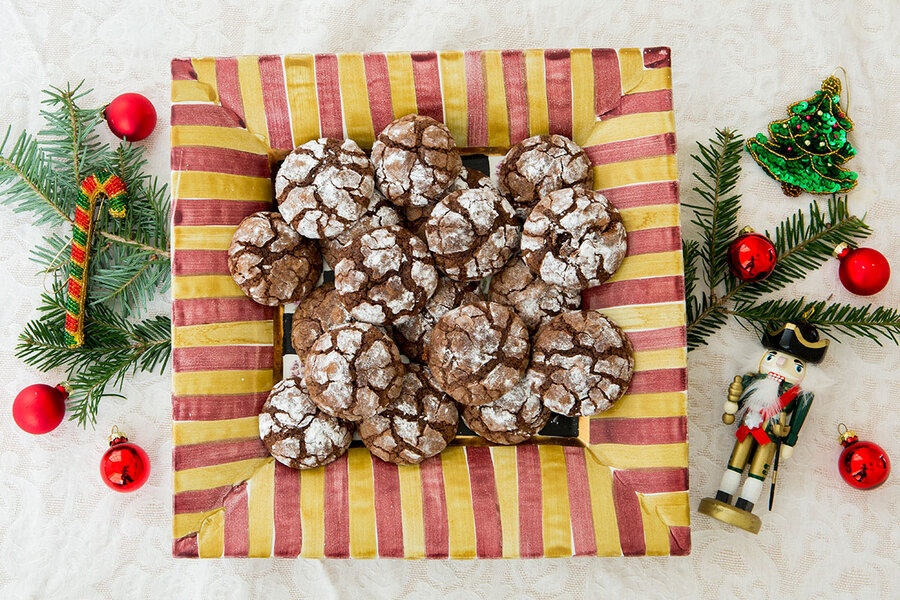Cookie history: from George Washington's house to US holiday fêtes
Every other year, Carol Ramos goes big for Christmas. This year she decorated her home with nine Christmas trees and held two separate holiday dessert parties – one for family and one for friends. But these parties weren’t cookie swaps. She bakes all the desserts herself.
“This year it was over 50 dozen cookies,” says Ms. Ramos, a finance director from Santa Clara, Calif., via email. She also baked cookies for a benefit for a domestic violence shelter and filled countless goodie bags tied with ribbons as gifts for friends and coworkers. “It’s a way of sharing something I love to do and people seem to appreciate it more than anything else,” she says.
The words “Christmas” and “cookie” go hand-in-hand this time of year and the tiny sweet morsels can be found in centuries-old holiday traditions around the globe. In the United States, yearly classics include sugar cookies, gingerbread people with raisin eyes and lopsided smiles, molasses thumbprint cookies, and powdered Russian tea cakes (also known as Mexican wedding cakes), among many others. The aroma of cinnamon, nutmeg, cloves, and a hint of citrus signal the holidays like nothing else.
Recipes have long served as cross-cultural pollinators, generously shared and fiercely protected as they are handed down from generation to generation. Like snowflakes, no two are exactly alike.
Recent trends show home cooks are even willing to experiment a bit with traditional favorites, such as combining chocolate with rosemary or thyme in a good base recipe, says Julia Collin Davison, co-host of the TV show America’s Test Kitchen, in Boston.
“Just taking simple little things and elevating your sugar cookie to a browned-butter, rosemary sugar cookie is suddenly really interesting,” says Ms. Collin Davison. “All you need are two flavors that go together and are somewhat unusual and you have something modern.”
If gingerbread with a hint of garam masala seems a bit too modern for your tastes, consider the recipe for “Another Christmas Cookey” in what is widely considered the first American cookbook, “American Cookery” by Amelia Simmons published in 1796:
To three pound flour, sprinkle a tea cup of fine powdered coriander seed, rub in one pound butter, and one and half pound sugar, dissolve three tea spoonfuls of pearl ash in a tea cup of milk, kneed all together well, roll three quarters of an inch thick, and cut or stamp into shape and size you please, bake slowly fifteen or twenty minutes; tho' hard and dry at first, if put into an earthern pot, and dry cellar, or damp room, they will be finer, softer and better when six months old.
Like many early recipes, “Another Christmas Cookey” leaves much to the interpretation of the home cook working over an open fire. Cast iron cook stoves didn’t arrive in homes until the 1830s and even then temperatures and bake times were largely guesswork.
But Ms. Simmons herself didn’t create the Christmas cookie, historians say, she was simply reflecting a trend of the time. Hidden within “Another Christmas cookey” are clues that point the recipe’s origins to the Hudson Valley Dutch in New York, says William Woys Weaver, a food historian and cookbook author in Devon, Pa.
“The American word ‘cookie’ comes from the Holland Dutch word koekje, a diminutive of koek (cake), which was the New Year’s cake,” says Mr. Weaver, author of “Dutch Treats.” These small cakes were offered as part of the Holland Dutch open-house tradition on New Year’s Day. “The theory is that when George Washington was living in New York he held open house [receptions] and used this local Dutch tradition of serving these cakes. And it just became very fashionable,” he says.
Tracing the cookie even further back to Europe in the Middle Ages, small decorative cakes were the work of highly trained artisanal or court bakers, and never home cooks, says Weaver. The bakers used wooden molds carved with intricate images to create eye-appealing treats. The sweet cakes were sold on holidays or festive occasions, such as a royal wedding.
It was only when the middle class became better off and ingredients more widely available and affordable did home cooks start replicating cookies in their own kitchens.
“When baking became industrialized in the 19th century, you no longer had this culture of carving these beautiful molds,” says Weaver. “You had tin cutters and you did the details with icing.”
While many Christmas cookies do come laden with frosting, tiny silver balls, or sprinkles, they don’t have to be, says Ramos. Her most requested recipe this year: brownie-stuffed chocolate chip cookies.
“If they’re well made, their recipients will like them, whether they’re fancy or not,” she says. Her tried-and-true tips for the holiday harried: Stick to cookies where you can make the dough ahead of time. Simply portion the dough into balls, and then put them in freezer bags marked with the cookie name, oven temperature, and baking time. Then bake the day they are needed. “There’s nothing worse than stale, dry cookies,” says Ramos.
But if Christmas Eve is approaching and your cookie jar is still empty, don’t fret. You can always search out and support a local baker, says Weaver.
“If you want to make your family happy, pick something that’s very special – you don’t even have to bake cookies – concentrate on it, and then let that be your gift for the holidays,” he says.
* * * * *
Last year for our first Christmas together, my husband wistfully referred to chocolate powdered cookies his mom used to bake. So she generously copied and sent me the recipe for these Chocolate Crinkles. Chilling the dough and dipping them in confectioners’ sugar had me worried they would be too complicated or time consuming. But these were easy. They are best eaten the day they are baked.
Chocolate Crinkles
Makes about 6 dozen cookies
1/2 cup vegetable oil
4 squares unsweetened chocolate (4 ounces), melted
2 cups granulated sugar
4 eggs
2 teaspoons vanilla
2 cups all-purpose flour
2 teaspoons baking powder
1/2 teaspoon salt
1 cup confectioners’ sugar
1. Melt the chocolate in a saucepan on the stovetop over low heat, or use a double boiler if you have one.
2. In large bowl, mix together the oil, melted chocolate, and sugar.
3. Stir in one egg at a time until well mixed.
4. Add vanilla, flour, baking powder, and salt, and stir well to combine.
5. Chill at least two hours or overnight.
6. Preheat oven to 350 degrees F. and grease a cookie sheet.
7. Measure out confectioners’ sugar into a small bowl.
8. Using a teaspoon, drop dough into sugar; roll until coated on all sides, and form into a ball.
9. Place about 2 inches apart on the greased cookie sheet.
10. Bake 10 to 12 minutes, maybe even less. Be sure you don’t over bake!
11. Remove promptly from cookie sheet and cool on a wire rack.






